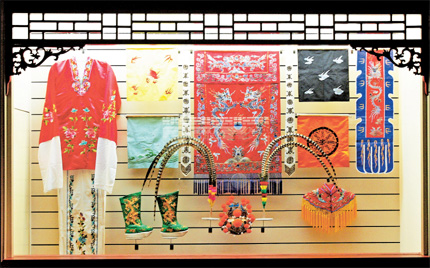Baoshan's global trove of folk art
 |
| Flamboyant costumes and accessories for traditional Chinese opera are displayed at the China Hall. |
Expo guests too hurried to take in the arts and culture can visit the just-opened Baoshan Folk Art Museum in a serene setting, complete with dragon boats, Rio carnival costumes and bucking bulls from the American West. Yao Minji reports.
An enormous red wooden dragon boat hangs suspended from the ceiling, the prow dragon's jaws are gaping and the tendrils of its whiskers trail below to welcome visitors.
The dragon, surrounded by dozens of hanging red lanterns, is the first thing visitors see when entering the Baoshan International Folk Arts Exposition at the Baoshan Folk Art Museum.
The museum and its first Expo-related cultural exhibition opened last weekend in Gucun Park on Hutai Road in northern Shanghai.
Fascinating folk arts from around the world are collected in a modern minimalist gray building designed to appear (looking down, from a bird's-eye view) like a traditional Chinese knot.
The World Expo 2010 in Shanghai has gathered folk arts from around the world, but many visitors are too rushed at the main Expo site to appreciate them.
They can take a much slower and deeper look at the works in this Baoshan museum. The hall has scheduled a series of folk arts exhibitions.
"We hope the opening of this exposition will enrich the cultural and artistic content of the district, establish a platform for communication and exchange and become a cultural theme park beloved by residents," says Si Fumin, the district's director.
The museum is designed like a traditional Chinese knot, a decorative handicraft art and symbol of folk art in the Tang (AD 618-907) and Song dynasties (960-1279). It is situated near vast green fields, near a calm lake and peaceful bridge.
On the first floor, eight exhibition halls form flower "knots;" a long corridor extending into the lake symbolizes hanging tassels; the short corridor at the top is the red thread for hanging the knot.
The museum features not only exhibits protected behind glass but also interactive exhibitions that visitors can experience.
Passing under the giant dragon boat in the Preface Hall, visitors enter Baoshan Hall to see a replica of a typical Luodian dragon boat, a delicately made vessel displaying the special regional features of dragon boats in the Wuyue area (now Zhejiang and Jiangsu provinces).
Luodian, an ancient town in Baoshan District, has carried on the tradition of dragon boat racing for 641 years.
Once a typical fishermen's home, Luodian learned the craft of making dragon boats and the accompanying celebration from nearby Suzhou in Jiangsu Province. First observed as worship ceremony to the god of the ocean, it later developed into a regional celebration.
In the Qing Dynasty (1644-1911), about 200 years ago, dragon boat racing in Luodian Town has transformed from a lively prayer at certain times of the year to a frequently held event. Each boat has its own passionate fans.
The competitions were often accompanied with various folk performances, ceremonies and celebrations.
Unlike the much simpler ones for modern competition, these boats retain their raised dragon's head and raised tail in the stern. The dragon's claws on the hull clasp several different traditional Chinese weapons. This resembles the prototype dragon boats in Suzhou except that the small structure on the boat resembles a 500-year-old house in Luodian.
Visitors can play interactive desktop games and race dragon boats against each other.
"It's a very simple game and I never expected to see an interactive game in a museum, but this suits the hall perfectly," says Wang Li, a 29-year-old Luodian visitor. "It's quite refreshing to see our traditions to be presented in a modern and entertaining way."
It is not the only interactive exhibition.
 0
0 







Go to Forum >>0 Comments